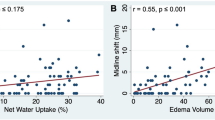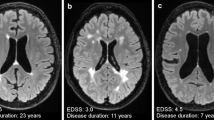Abstract
Conventional neuroradiological techniques, such as computed tomography (CT) and magnetic resonance imaging (MRI), make a fundamental contribution in both the acute and chronic phases of stroke. Recent years have witnessed the development of new imaging modalities, which include diffusion-weighted imaging (DWI), perfusion-weighted imaging (PWI), CT-angiography (CTA), MR-angiography (MRA), magnetic resonance spectroscopy (MRS), diffusion tensor imaging (DTI) and functional MRI (fMRI). While CTA, MRA, DWI and PWI are commonly used for clinical purposes, DTI, MRS and fMRI are becoming increasingly important in the field of experimental research of cerebrovascular diseases, but are still far from becoming of primary usefulness in the everyday clinical setting.
Similar content being viewed by others
References
Brown MM, Markus H, Oppenheimer S (2006) Stroke medicine. Taylor & Francis: Oxon
Inoue Y, Takemoto K, Miyamoto T et al (1980) Sequential computed tomography scans in acute cerebral infarction. Radiology 135:655–662
Bozzao L, Bastianello S, Fantozzi LM et al (1989) Correlation of angiographic and sequential CT findings in patients with evolving cerebral infarction. AJNR Am J Neuroradiol 10:1215–1222
Hacke W, Kaste M, Fieschi C et al (1995) Intravenous thrombolysis with recombinant tissue plasminogen activator for acute hemispheric stroke. The European Cooperative Acute Stroke Study (ECASS). JAMA 274:1017–1025
Hill MD, Demchuk AM, Tomsick TA et al (2006) Using the baseline CT scan to select acute stroke patients for IV-IA therapy. AJNR Am J Neuroradiol 27:1612–1616
Toni D, Fiorelli M, Bastianello S et al (1996) Hemorrhagic transformation of brain infarct: predictability in the first five hours from stroke onset and influence on clinical outcome. Neurology 46:341–345
Bastianello S, Pierallini A, Colonnese C et al (1991) Hyperdense middle cerebral artery CT sign: comparison with angiography in the acute phase of ischemic supratentorial infarction. Neuroradiology 33:207–211
Pantano P, Caramia F, Bozzao L et al (1999) Delayed increase in infarct volume after cerebral ischemia: correlations with thrombolytic treatment and clinical outcome. Stroke 30:502–507
Wintermark M, Reichhart M, Cuisenaire O et al (2002) Comparison of admission perfusion computed tomography and qualitative diffusion-and perfusion-weighted magnetic resonance imaging in acute stroke patients. Stroke 33:2025–2031
Warach S, Chien D, Li W et al (1992) Fast magnetic resonance diffusion-weighted imaging of acute human stroke. Neurology 42:1717–1723
Lovblad KO, Laubach HJ, Baird AE et al (1998) Clinical experience with diffusion-weighted MR in patients with acute stroke. AJNR Am J Neuroradiol 19:1061–1066
Baird AE, Benfield A, Schlaug G et al (1997) Enlargement of human cerebral ischemic lesion volumes measured by diffusion-weighted magnetic resonance imaging. Ann Neurol 41:581–589
Schlaug G, Siewert B, Benfield A et al (1997) Time course of apparent diffusion coefficient (ADC) abnormality in human stroke. Neurology 49:113–119
Rosen BR, Belliveau JW, Vevea JM et al (1990) Perfusion imaging with NMR contrast agents. Magn Reson Med 14: 249–265
Barber PA, Darby DG, Desmond PM et al (1999) Identification of major ischemic change. Diffusion-weighted imaging versus computed tomography. Stroke 30:2059–2065
Hjort N, Butcher K, Davis SM et al (2005) UCLA Thrombolysis Investigators. Magnetic resonance imaging criteria for thrombolysis in acute cerebral infarct. Stroke 36:388–397
Wintermark M, Albers GW, Alexandrov AV et al (2008) Acute stroke imaging research roadmap. AJNR Am J Neuroradiol 29:e23–e30
Parsons MW, Yang Q, Barber PA et al (2001) Perfusion magnetic resonance imaging maps in hyperacute stroke: relative cerebral blood flow most accurately identifies tissue destined to infarct. Stroke 32: 1581–1587
Kidwell CS, Saver JL, Mattiello J et al (2000) Thrombolytic reversal of acute human cerebral ischemic injury shown by diffusion/perfusion magnetic resonance imaging. Ann Neurol 47:462–469
Pantano P, Toni D, Caramia F et al (2001) Relationship between vascular enhancement, cerebral hemodynamics and MR angiography in acute stroke patients. AJNR Am J Neuroradiology 22:255–260
Chollet F, DiPiero V, Wise RJ et al (1991) The functional anatomy of motor recovery after stroke in humans: a study with positron emission tomography. Ann Neurol 29:63–71
Cramer SC, Nelles G, Benson RR et al (1997) A functional MRI study of subjects recovered from hemiparetic stroke. Stroke 28:2518–2527
Cao Y, D’Olhaberriague L, Vikingstad EM (1998) Pilot study of functional MRI to assess cerebral activation of motor function after poststroke hemiparesis. Stroke 29:112–122
Feydy A, Carlier R, Roby-Brami A et al (2002) Longitudinal study of motor recovery after stroke: recruitment and focusing of brain activation. Stroke 33:1610–1617
Ward NS, Broen MM, Thompson AJ et al (2003) Neural correlates of motor recovery after stroke: a longitudinal fMRI study. Brain 126:2476–2496
Richards LG, Stewart KC, Woodbury ML et al (2008) Movement-dependent stroke recovery: a systematic review and meta-analysis of TMS and fMRI evidence. Neuropsychologia 46:3–11
Pariente J, Loubinoux I, Carel C et al (2001) Fluoxetine modulates motor performance and cerebral activation of patients recovering from stroke. Ann Neurol 50:718–729
Mori S, Zhang J (2006) Principles of diffusion tensor imaging and its applications to basic neuroscience research. Neuron 51:527–539
Thomalla G, Glauche V, Koch MA et al (2004) Diffusion tensor imaging detects early Wallerian degeneration of the pyramidal tract after ischemic stroke. Neuroimage 22:1767–1774
Liang Z, Zeng J, Liu S et al (2007) A prospective study of secondary degeneration following subcortical infarction using diffusion tensor imaging. J Neurol Neurosurg Psychiatry 78:581–586
Møller M, Frandsen J, Andersen G et al (2007) Dynamic changes in corticospinal tracts after stroke detected by fibretracking. J Neurol Neurosurg Psychiatry 78:587–592
Liang Z, Zeng J, Zhang C et al (2008) Longitudinal investigations on the anterograde and retrograde degeneration in the pyramidal tract following pontine infarction with diffusion tensor imaging. Cerebrovasc Dis 25:209–216
Gideon P, Henriksen O, Sperling B et al (1992) Early time course of N-acetylaspartate, creatine and phosphocreatine, and compounds containing choline in the brain after acute stroke. A proton magnetic resonance spectroscopy study. Stroke 23:1566–1572
Rothman DL, Howseman AM, Graham GD et al (1991) Localized proton NMR observation of [3–13C] lactate in stroke after [1–13C] glucose infusion. Magn Reson Med 21:302–307
Gillard JH, Barker PB, van Zijl PC et al (1996) Proton MR spectroscopy in acute middle cerebral artery stroke. AJNR Am J Neuroradiol 17:873–886
Pereira AC, Saunders DE, Doyle VL et al (1999) Measurement of initial N-acetyl aspartate concentration by magnetic resonance spectroscopy and initial infarct volume by MRI predicts outcome in patients with middle cerebral artery territory infarction. Stroke 30:1577–1582
Parsons MW, Li T, Barber PA et al (2000) Combined (1)H MR spectroscopy and diffusion-weighted MRI improves the prediction of stroke outcome. Neurology 55:498–505
Nicoli F, Lefur Y, Denis B et al (2003) Metabolic counterpart of decreased apparent diffusion coefficient during hyperacute ischemic stroke: a brain proton magnetic resonance spectroscopic imaging study. Stroke 34:82–87
Author information
Authors and Affiliations
Corresponding author
Rights and permissions
About this article
Cite this article
Pantano, P., Totaro, P. & Raz, E. Cerebrovascular diseases. Neurol Sci 29 (Suppl 3), 314–318 (2008). https://doi.org/10.1007/s10072-008-1006-2
Published:
Issue Date:
DOI: https://doi.org/10.1007/s10072-008-1006-2




